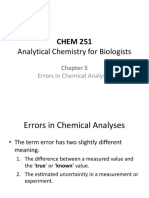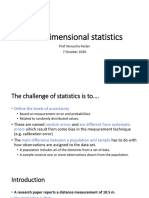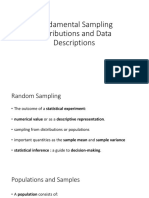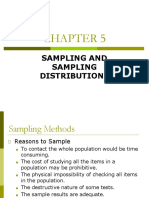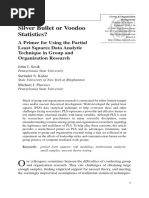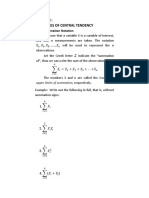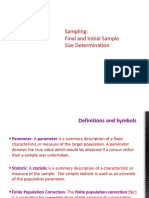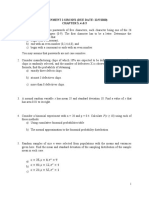Random Errors in Chemical Analysis
Uploaded by
Dave MarimonRandom Errors in Chemical Analysis
Uploaded by
Dave MarimonRandom Errors in Chemical
Analysis
A. Nature of Random Errors
Uncontrollable variables are the source of
random errors
Contributors to random errors are not all
identifiable
individually detectable
quantifiable
The combined effect of random errors produce
the fluctuation of replicate measurements
around the mean
Random errors are the major source of uncertainty
Distribution of Random Errors
Assume four contributors to the random error of equal magnitude.
qual probability of occurrence of negative and positive deviation.
ach can cause the final result to be high or lo! by "U
1:4:6:4:
1
Frequency of Occurrence and Probability
The frequency of
a deviation of a
given
magnitude is a
measure of the
probability of
occurrence of that
deviation
!."#
$".%# $".%#
6.$"#
6.$"#
#or ten equal si$e
uncertainty
&aussian 'ur(e or Normal Error 'ur(e
#or a very
large
number of
individual
errors
Re)licate Data on t*e 'alibration of a 1%m+ Pi)et
&eneratin, a *isto,ram
Frequency -it*in ran,es
Distribution of t*e E.)erimental Errors A))roac*es
a &aussian 'ur(e
A % &ar 'raph or (istogram & 'aussian Curve
/ources of Random 0ncertainties
). *isual +udgments
,. *ariations in the drainage time and in
the angle of the pipet as it drains
-. Temperature fluctuations
.. *ibration and drafts that cause small
variations in the balance readings.
/tatistical 1reatment of Random
Errors
/istribution of the majority of analytical data
displays characteristics of the normal
distribution
Therefore0 'aussian distribution is used to
appro1imate distribution of analytical data
Available standard statistical methods are
used
to evaluate analytical data assuming random
distribution of errors
1erminolo,y
2opulation3 all possible observations4
measurements4a universe of data
Types of population
#inite and real 5lot of steel0 a lot of Advil Tablets6
(ypothetical or conceptual 5Calcium in blood0 lead in
la7e 8ntario6.
A sample of the population is analy$ed
9ample3 subset of the population
Results from the analysis are used to infer the
characteristics of the population
Pro)erties of &aussian 'ur(es
The gaussian curve
is
fully characteri$ed by
t!o parameters
the mean3:
the standard
deviation3;
2opulation mean
5:6 and
9tandard
/eviation5;6
0ni(ersal &aussian 'ur(e
Abscissa3
deviation from
the mean in
units of standard
deviation
Pro)erties of a normal error cur(e
<ean occurs a the central point of
ma1imum
frequency
9ymmetrical distribution of positive and
negative
deviations
1ponential decrease in frequency as the
magnitude of the deviations increases
1*e /am)le /tandard De(iation
=umber of degrees of
freedom3 number of
independent results
needed to compute the
standard deviation
As = approaches
infinity0
s approaches ; and
approaches :
E.am)le
The follo!ing results !ere obtained in the
replicate analysis of a blood sample for its lead
content3 >.?@,0 >.?@A0 >.?@,0 >.?@)0 and >.?A>
ppm 2b. Calculate the mean and the standard
deviation of this set of data.
9ample Bi B,
>.?@, >.@A@@>.
>.?@A >.@?)@-A
>.?@, >.@A@@>.
>.?@) >.@A.>>)
>.?A> >.@??A
sumBi C -.??) ,.D..).@
mean C >.?@.,ppm 2b
9 C >.>>-?AD
Assi,nment
). Consider the sets of replicate.
Calculate3 a. mean b. median c.
spread d. standard deviation
a. ,..0 ,.)0 ,.)0 ,.-0 ).@
b. AE.E.0 AE.E,0 AE.D>
c. >.>E>,0 >.>DD.0 >.>DDA0 >.)>>>
/tandard Error of t*e 2ean
The standard
deviation of the
mean
C standard error
of
the mean
Pooled /tandard De(iation
Relati(e /tandard De(iation
/i,nificant Fi,ures
All certain digits plus one uncertain digit
Rules
All initial $eros are not significant
All final $eros are not significant0 unless they
follo! a decimal point
Feros bet!een non$ero digits are significant
All remaining digits are significant
Use scientific notation to e1clude $eros
that are not significant
/i,nificant fi,ures in Numerical
'om)utations
You might also like
- 3141b86-6fd4-7726-D8ad-20a1516bcd Statistics Interview Cheat Sheet - Emmading - Com. All Rights Reserved.No ratings yet3141b86-6fd4-7726-D8ad-20a1516bcd Statistics Interview Cheat Sheet - Emmading - Com. All Rights Reserved.10 pages
- Ebook Business Statistics 3Rd Edition Donnelly Solutions Manual Full Chapter PDF100% (16)Ebook Business Statistics 3Rd Edition Donnelly Solutions Manual Full Chapter PDF58 pages
- Fundamentals of Biostatistics for Public Health StudentsFrom EverandFundamentals of Biostatistics for Public Health StudentsNo ratings yet
- Statistics: a QuickStudy Laminated Reference GuideFrom EverandStatistics: a QuickStudy Laminated Reference GuideNo ratings yet
- Statistics 1 (Final) / Orthodontic Courses by Indian Dental AcademyNo ratings yetStatistics 1 (Final) / Orthodontic Courses by Indian Dental Academy15 pages
- Analytical Chemistry - Random Errors in Chemical AnalysesNo ratings yetAnalytical Chemistry - Random Errors in Chemical Analyses39 pages
- Stat 315 - Homework 4 - Due Monday June 15, 2009: 5.5. A) Average Price: 1.690385No ratings yetStat 315 - Homework 4 - Due Monday June 15, 2009: 5.5. A) Average Price: 1.6903853 pages
- Week Systematic Errors and Random Errors in AnalysisNo ratings yetWeek Systematic Errors and Random Errors in Analysis9 pages
- File 1722526077 110208 PrinciplesofInstrumentation-SecondpartNo ratings yetFile 1722526077 110208 PrinciplesofInstrumentation-Secondpart28 pages
- data screening and main model analysis in spssNo ratings yetdata screening and main model analysis in spss26 pages
- Fundamental Sampling Distributions and Data DescriptionsNo ratings yetFundamental Sampling Distributions and Data Descriptions22 pages
- 8.3 Finite Population Correction Factor: Maida Balbin-Pili Engr. John Louie O. RafaelNo ratings yet8.3 Finite Population Correction Factor: Maida Balbin-Pili Engr. John Louie O. Rafael19 pages
- List of Important AP Statistics Concepts To KnowNo ratings yetList of Important AP Statistics Concepts To Know9 pages
- PHPS30020 Week1 (2) - 29nov2023 (Combined Sampling Variation - SEM SEP CIs)No ratings yetPHPS30020 Week1 (2) - 29nov2023 (Combined Sampling Variation - SEM SEP CIs)24 pages
- Animal Genetics & Breeding Unit - I: Standard Error & Coefficient of Variation %No ratings yetAnimal Genetics & Breeding Unit - I: Standard Error & Coefficient of Variation %12 pages
- Biology AS Level - Pptx-Unit 3 Practical SkillsNo ratings yetBiology AS Level - Pptx-Unit 3 Practical Skills14 pages
- 10. Confidence Intervals; Effect Size in Statistical Analysis Do My Findings MatterNo ratings yet10. Confidence Intervals; Effect Size in Statistical Analysis Do My Findings Matter23 pages
- Probabilistic Methods in Engineering: Lecture I: Introduction/MotivationNo ratings yetProbabilistic Methods in Engineering: Lecture I: Introduction/Motivation31 pages
- The Assumptions of Anova: Dennis Monday Gary Klein Sunmi LeeNo ratings yetThe Assumptions of Anova: Dennis Monday Gary Klein Sunmi Lee25 pages
- Lecture - 9 EstimationRM (ECON 1005 2011-2012)No ratings yetLecture - 9 EstimationRM (ECON 1005 2011-2012)52 pages
- Week 2. Errors in Chemical Analysis (Abstract)No ratings yetWeek 2. Errors in Chemical Analysis (Abstract)31 pages
- Why "Sample" The Population? Why Not Study The Whole Population?No ratings yetWhy "Sample" The Population? Why Not Study The Whole Population?9 pages
- Chapter 1 - Comparing Normal PopulationsNo ratings yetChapter 1 - Comparing Normal Populations39 pages
- Activity 2a - Qualitative Test For ProteinsNo ratings yetActivity 2a - Qualitative Test For Proteins4 pages
- Activity 2B - Precipitation Test For Protein100% (1)Activity 2B - Precipitation Test For Protein6 pages
- Economic Achievements of The Presidents of The Philippines Roxas - Arroyo0% (1)Economic Achievements of The Presidents of The Philippines Roxas - Arroyo8 pages
- Term For Slow and Deep Breathing With Regular RhythmNo ratings yetTerm For Slow and Deep Breathing With Regular Rhythm2 pages
- Rural/Urban: 1. Culture 2. Occupation 3. GeographyNo ratings yetRural/Urban: 1. Culture 2. Occupation 3. Geography9 pages
- Chap4 CALCULATIONS USED IN ANALYTICAL CHEMISTRY100% (1)Chap4 CALCULATIONS USED IN ANALYTICAL CHEMISTRY20 pages
- Axial Skeleton, ENDOSKELETON OF VERTEBRATESNo ratings yetAxial Skeleton, ENDOSKELETON OF VERTEBRATES52 pages
- Some Important Discrete Probability Distributions: Powerpoint To AccompanyNo ratings yetSome Important Discrete Probability Distributions: Powerpoint To Accompany8 pages
- (PDF Download) Applied Medical Statistics 1st Edition Jingmei Jiang Fulll Chapter100% (3)(PDF Download) Applied Medical Statistics 1st Edition Jingmei Jiang Fulll Chapter64 pages
- Econ 121: Statistics - I Course DescriptionNo ratings yetEcon 121: Statistics - I Course Description3 pages
- Sosik Et Al 2009 Silver Bullet or Voodoo Statistics A Primer For Using The Partial Least Squares Data AnalyticNo ratings yetSosik Et Al 2009 Silver Bullet or Voodoo Statistics A Primer For Using The Partial Least Squares Data Analytic32 pages
- Estimation of Students' Graduation Using Multiple Linear Regression MethodNo ratings yetEstimation of Students' Graduation Using Multiple Linear Regression Method8 pages
- Inferential Statistics (Hypothesis Testing)No ratings yetInferential Statistics (Hypothesis Testing)15 pages
- Download ebooks file Statistics for the Behavioral Sciences 4th Edition Susan A. Nolan all chapters100% (2)Download ebooks file Statistics for the Behavioral Sciences 4th Edition Susan A. Nolan all chapters55 pages
- Quantum Mechanics: Problems Lecture 1: Questions On ProbabilityNo ratings yetQuantum Mechanics: Problems Lecture 1: Questions On Probability4 pages
- ASSIGNMENT 2 SIM 3251 (DUE DATE: 22/5/2020) Chapter 3, 4 & 5No ratings yetASSIGNMENT 2 SIM 3251 (DUE DATE: 22/5/2020) Chapter 3, 4 & 53 pages
- Program Evaluation Review Technique (PERT) : Project Planning, Scheduling, and ControlNo ratings yetProgram Evaluation Review Technique (PERT) : Project Planning, Scheduling, and Control35 pages
- DC Full Handwritten Notes @Vtudeveloper.inNo ratings yetDC Full Handwritten Notes @Vtudeveloper.in305 pages
- 3.1 Basics of Pseudo-Random Numbers GeneratorsNo ratings yet3.1 Basics of Pseudo-Random Numbers Generators10 pages
- E211 - Operations Planning II: S S E E E E O O P PNo ratings yetE211 - Operations Planning II: S S E E E E O O P P17 pages
- 3141b86-6fd4-7726-D8ad-20a1516bcd Statistics Interview Cheat Sheet - Emmading - Com. All Rights Reserved.3141b86-6fd4-7726-D8ad-20a1516bcd Statistics Interview Cheat Sheet - Emmading - Com. All Rights Reserved.
- Ebook Business Statistics 3Rd Edition Donnelly Solutions Manual Full Chapter PDFEbook Business Statistics 3Rd Edition Donnelly Solutions Manual Full Chapter PDF
- Fundamentals of Biostatistics for Public Health StudentsFrom EverandFundamentals of Biostatistics for Public Health Students
- Statistics: a QuickStudy Laminated Reference GuideFrom EverandStatistics: a QuickStudy Laminated Reference Guide
- Statistics 1 (Final) / Orthodontic Courses by Indian Dental AcademyStatistics 1 (Final) / Orthodontic Courses by Indian Dental Academy
- Analytical Chemistry - Random Errors in Chemical AnalysesAnalytical Chemistry - Random Errors in Chemical Analyses
- Stat 315 - Homework 4 - Due Monday June 15, 2009: 5.5. A) Average Price: 1.690385Stat 315 - Homework 4 - Due Monday June 15, 2009: 5.5. A) Average Price: 1.690385
- Week Systematic Errors and Random Errors in AnalysisWeek Systematic Errors and Random Errors in Analysis
- File 1722526077 110208 PrinciplesofInstrumentation-SecondpartFile 1722526077 110208 PrinciplesofInstrumentation-Secondpart
- Fundamental Sampling Distributions and Data DescriptionsFundamental Sampling Distributions and Data Descriptions
- 8.3 Finite Population Correction Factor: Maida Balbin-Pili Engr. John Louie O. Rafael8.3 Finite Population Correction Factor: Maida Balbin-Pili Engr. John Louie O. Rafael
- PHPS30020 Week1 (2) - 29nov2023 (Combined Sampling Variation - SEM SEP CIs)PHPS30020 Week1 (2) - 29nov2023 (Combined Sampling Variation - SEM SEP CIs)
- Animal Genetics & Breeding Unit - I: Standard Error & Coefficient of Variation %Animal Genetics & Breeding Unit - I: Standard Error & Coefficient of Variation %
- 10. Confidence Intervals; Effect Size in Statistical Analysis Do My Findings Matter10. Confidence Intervals; Effect Size in Statistical Analysis Do My Findings Matter
- Probabilistic Methods in Engineering: Lecture I: Introduction/MotivationProbabilistic Methods in Engineering: Lecture I: Introduction/Motivation
- The Assumptions of Anova: Dennis Monday Gary Klein Sunmi LeeThe Assumptions of Anova: Dennis Monday Gary Klein Sunmi Lee
- Why "Sample" The Population? Why Not Study The Whole Population?Why "Sample" The Population? Why Not Study The Whole Population?
- Quantile Regression: Estimation and SimulationFrom EverandQuantile Regression: Estimation and Simulation
- Economic Achievements of The Presidents of The Philippines Roxas - ArroyoEconomic Achievements of The Presidents of The Philippines Roxas - Arroyo
- Term For Slow and Deep Breathing With Regular RhythmTerm For Slow and Deep Breathing With Regular Rhythm
- Rural/Urban: 1. Culture 2. Occupation 3. GeographyRural/Urban: 1. Culture 2. Occupation 3. Geography
- Some Important Discrete Probability Distributions: Powerpoint To AccompanySome Important Discrete Probability Distributions: Powerpoint To Accompany
- (PDF Download) Applied Medical Statistics 1st Edition Jingmei Jiang Fulll Chapter(PDF Download) Applied Medical Statistics 1st Edition Jingmei Jiang Fulll Chapter
- Sosik Et Al 2009 Silver Bullet or Voodoo Statistics A Primer For Using The Partial Least Squares Data AnalyticSosik Et Al 2009 Silver Bullet or Voodoo Statistics A Primer For Using The Partial Least Squares Data Analytic
- Estimation of Students' Graduation Using Multiple Linear Regression MethodEstimation of Students' Graduation Using Multiple Linear Regression Method
- Download ebooks file Statistics for the Behavioral Sciences 4th Edition Susan A. Nolan all chaptersDownload ebooks file Statistics for the Behavioral Sciences 4th Edition Susan A. Nolan all chapters
- Quantum Mechanics: Problems Lecture 1: Questions On ProbabilityQuantum Mechanics: Problems Lecture 1: Questions On Probability
- ASSIGNMENT 2 SIM 3251 (DUE DATE: 22/5/2020) Chapter 3, 4 & 5ASSIGNMENT 2 SIM 3251 (DUE DATE: 22/5/2020) Chapter 3, 4 & 5
- Program Evaluation Review Technique (PERT) : Project Planning, Scheduling, and ControlProgram Evaluation Review Technique (PERT) : Project Planning, Scheduling, and Control
- E211 - Operations Planning II: S S E E E E O O P PE211 - Operations Planning II: S S E E E E O O P P






